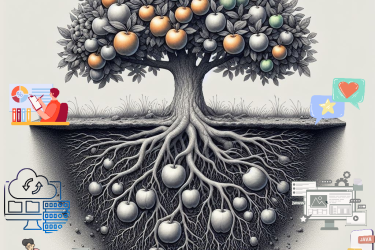More and more interactive products are being returned. In 2002, 48% of all returned products were technically fully functional but were rejected for failing to satisfy user needs (28%) or purely due to users’ remorse (20%). Even though a product may have all the features one can hope for, complexity and bad user experience can prevent users from integrating it into their lives.
User experiences are subjective and dynamic, but by and large, interactive products are not designed to take people’s changing capacity and experience into account. But they could. Here, I present a model for how designers can use the fundamentals of video games and the psychological principles of flow to design enhanced user experiences.

GOING WITH THE FLOW
In 1975, the Hungarian psychology professor Mihaly Csikszentmihalyi outlined his theory of “flow” in his seminal work, Flow: The Psychology of Optimal Experience. He defined the concept as ‘‘the holistic experience that people feel when they act with total involvement.’’ When in the flow state, people become absorbed in their activity, narrowing their awareness to the activity itself, losing self-consciousness, and feeling in control of their environment. Flow is also proven to have a positive impact on learning. In skiing, novice practitioners are advised to spend the first few days at the green beginner slopes to get the best learning experience. On the other hand, experienced skiers will find themselves bored at the beginner slopes and must seek their optimal experience on the black expert slopes. This individual balance between skill and challenge is, according to Csikszentmihalyi, called the “flow zone” and staying in this flow zone is the best possible way to learn and make progress while still feeling constantly challenged and intrinsically motivated.
While flow has been extensively applied in studying a broad range of contexts, such as sports, shopping, rock climbing, dancing and others, I believe that, by drawing inspiration from video games, flow can be used to improve the user experience in interactive electronic consumer products.
VIDEO GAMES
Video games have evolved from simple games, where users had to bounce a ball around the screen, into advanced three-dimensional multiplayer environments. Modern video games feature social interaction, engaging cognitive processes, and complex challenges. One should think this increased complexity would result in games being too challenging for novice gamers, but the fact is that some of the best-selling games on the market are among the most complex. Some even succeed in entertaining novice as well as expert gamers in the same virtual world. One of the keys to this success is the effective implementation of the principles of flow, which has been found to have a great influence on the way players experience and value video games.
World of Warcraft (WoW), a massively multiplayer online role-playing game (MMORPG), has 12 million players. When entering WoW as a player on a novice level, you first encounter basic challenges that slowly introduce you to the universe and its mechanics. As you complete these quests, you gain Experience Points (XP) and your character’s level rises. Higher levels unlock new challenges, functionalities, and increasing difficulty. Eventually, you’re introduced to the full potential of the game, with challenges the involve social interactions with other players.
This system allows every player to stay in his or her individual flow zone, and progress through the game at own pace while constantly feeling challenged and intrinsically motivated. (Research confirms that playing World of Warcraft is just as cognitively challenging for novice players as for proficient ones, contributing to the long-term value of the game.) Just as computer games use the flow principles to create a user experience that reflects the skills of the user, so should interactive electronic consumer products. Can user experiences be designed to adapt responsively the challenges of product interactions to the skills of the user to enhance usability and learnability and provide the user with a pro-longed positive experience?
COMPLEX TELEVISIONS
Televisions have evolved from being signal receivers into universal multimedia hubs offering features such as Skype, Internet browsing, hard-drive recording, streaming online content, and apps, making operating a television much more complicated than it ever has been before. The complexity itself is not a bad thing. We do not buy televisions for their simplicity but for their features. However, complexity can be managed and presented in a manner that reduces clutter, confusion, and cognitive workload. In order to design a prolonged user experience, complexity has to be sequenced into challenges that match the skills of the users, giving them the chance to learn progressively and feel satisfied while doing so.
For this essay, I’ve chosen to focus on the Samsung E8005 SmartTV television. SmartTVs, also known as hybrid TVs or Connected TVs, are televisions that are integrated with the Internet. These devices have a higher focus on online interactive media, Internet TV as well as on-demand streaming media. Reviewers have described the new Samsung SmartTV’s as hard to use, clumsy, and unintuitive.

LEARNING HOW TO USE COMPLEX PRODUCTS IS LIKE LEARNING A COMPUTER GAME
Just like the challenges in video games match the skills of the user, so should TV interactions. For reference, I’ve used four levels described in the Dreyfus model of skill acquisition.
Level 1: Novice
• Rigid adherence to taught rules or plans
• No exercise of “discretionary judgment”
Level 2: Advanced beginner
• Limited “situational perception”
• All aspects of work treated separately with equal importance
Level 3: Competent
• “Coping with crowdedness” (multiple activities, accumulation of information)
• Some perception of actions in relation to goals
• Deliberate planning
• Formulates routines
Level 4: Proficient
• Holistic view of situation
• Prioritizes importance of aspects
• “Perceives deviations from the normal pattern”
• Employs maxim for guidance, with meanings that adapt to the situation at hand
The skill level of a user reflects what kind of product interactions they are capable of carrying out. Simple interactions, such as turning on the television and switching channels, are universal and common interactions known to most novice users of televisions. However, installing new hardware upgrades using the Samsung Evolution Kit requires users to open a compartment in the back of the television and attach a new chip to the motherboard–a task most novice users may find confusing and too challenging. In order to match the skill level of the user, all product interactions need to be assessed for their challenge level.
Novice users are expected to be able to turn on the television, adjust the volume, switch channel, and open the “Smarthub” dashboard. Furthermore, this means an advanced beginner user with a skill level of 2, is expected to be able to carry out interactions such as recording content from broadcast TV, install applications and share content via “connect share.”
Like in video games, a user can advance to the next level based on the number of XP that she has accumulated. Any successfully executed interaction results in more XP matching the level of challenge. For turning on the TV, a novice will be awarded 10 XP, for scheduling a TV recording a user would earn 40 XP. A user can advance to the next level only by reaching of the XP milestones corresponding to each level.
Different challenge levels award different amounts of XP, to prevent users from only carrying out novice interactions and eventually progressing to new skill levels. New skill levels should preferably only be reached by using more challenging features of the television.

WHAT YOU SEE IS WHAT YOU CAN DO
The skill level of a user indicates how challenging the interactions can be. Based on this concept, the interface of the future television and remote control should match the appropriate level of challenge to the user’s skill level. In this future interface, the skill level of the user dictates which interactions are available. Turn on the TV, can you get 10 XP; chose “Watch Television” and you get 10 more. At that point, only the least challenging interactions, such as volume and channel, are displayed. After switching channels and adjusting the volume, the user accumulates enough Exp to advance to skill level 2, meaning he or she is now considered an advanced beginner.
To nudge the user to try out more challenging interactions, a message appears on the screen and/or remote control stating: “Did you know: You can record what you see? View an overview of all channels? Setup the television to match your needs? Try it out now!”
New buttons appear on the remote control, giving the user access to more advanced interactions, which are highlighted with a colorful ribbon labeled “Try!” The ribbon serves as a continuous reminder of the new possibilities that have yet to be explored. By completing any of the newly revealed interactions, the user is awarded 20 Exp and the ribbon disappears.
Of course, there will be users buying televisions who are already familiar with technology. They may not consider themselves novice users and may have a need to instantly unlock the full potential of the product. To address this need, an “advanced button” can be activated, which removes the sequenced presentation of increasingly challenging interactions.
CONCLUSION
The above use-case is the initial concept for a responsive user experience. Further research would test whether the map of interactions is really correct; further prototyping provide valuable insights on how different users interact to this framework. (One open question: Does the advanced button help experienced users or just make things more complicated for the impatient user?) But one of the main challenges here is that the ultimate goal of role-play gaming is progress skill acquisition. The goal of operating a television is finding the right content to watch. Progress in any UI should be fitted to the user’s goals. How do we do that for TV’s and beyond?
(Ref: FastCoDesign)


